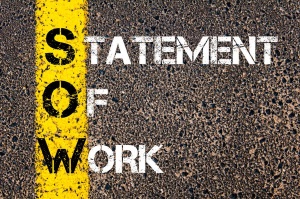Over 41 years of project delivery experience has taught me something that stands above all else when it comes to project performance. That something is – project performance always comes down to meeting or exceeding the customer’s expectations. And when/where are those expectations set? In most Professional/Consulting services teams it usually starts with a sales person(s) who writes and presents a proposal to the customer.
 Upon acceptance of a proposal, the delivery team takes the hand-off and with some collaborative process with sales, a statement of work is created for review and agreement by both parties. That hand-off from sales, and the precision (or lack thereof) of the SOW creation, form the basis for a customers’ expectation of a project outcome(s).
Upon acceptance of a proposal, the delivery team takes the hand-off and with some collaborative process with sales, a statement of work is created for review and agreement by both parties. That hand-off from sales, and the precision (or lack thereof) of the SOW creation, form the basis for a customers’ expectation of a project outcome(s).
The statement of work sets the foundation for the scope, financial terms (price, payment terms, etc.) and delivery terms for your project. SOWs with incomplete or inaccurate details can often result in tension and conflict within delivery teams, contribute to unsatisfied customers, and possibly introduce potential legal and/or financial risks. Poorly written SOWs containing inexplicit terms and ambiguous scope, set a project up to fail. In our eleven years of conducting dozens of project performance reviews for our customers, we often find the statement of work as a primary source or at least significant contributor to failed projects simply because the customers’ expectations were mis-aligned from what the vendor intended to deliver. We know which entity usually loses the argument when push comes to shove with a customer complaint!
It would be true that most organizations have some sort of SOW process and/or templates to use to bring some consistency and quality to creating better SOWs – so where do the SOWs fail? There are eight primary reasons we at RTMC have observed most often. They are:
- Not enough detail; too general
- Open ended or ambiguous description of deliverables
- Reads like a marketing piece (i.e. not specific enough in the language)
- It was not treated as part of the main contract process leading to its’ content conflicting with references in the main agreement (such as a master agreement to which the SOW is tied in some way)
- It fails to fill in all the blanks left by the main agreement
- It does not account for all the services wanted/needed by the customer or improperly estimates the required scope of effort
- The SOW does not explicitly define what is excluded
- Human error(s)
What we find most often leading to these failures include:
- Lack of a commitment in the organization to elevate the importance of the SOW and therefore the processes supporting each SOW with its ultimate (negative) impact on project performance and customer service
- Momentum of legacy processes! Unless your company is quite new, you are probably living with a SOW/process that was crafted some time ago, has changed ownership hands many times, and ownership of the SOW in the enterprise is a hot potato between sales, delivery, finance and the legal department.
- Inconsistent application of whatever the SOW/process is in the enterprise. A symptom of this is the lack of training for existing and newly on-boarded employees.
Getting to an improved statement of work process in the enterprise begins with a top down commitment to ownership/accountability, and then a serious review of existing SOW processes and template(s) to address whatever deficiencies may exist today.
With eleven years helping Professional and Consulting services teams address SOW related issues, RTMC can help in a consultative manner by reviewing your existing processes and even a sampling of your SOWs to make suggestions for process and template improvements. We also have a terrific course that teaches you ‘The Art of Writing a Statement of Work’. Students will learn all the key elements of a well written SOW, common pitfalls, best practices and more to help your organization make the SOW process in your company a strength leading to better project outcomes and improved customer satisfaction. For more information about the course go to our PS University website or write us at training@rtmconsulting.net.
